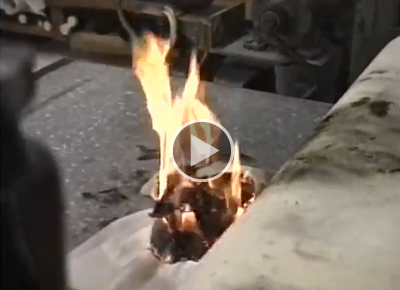Cage’s Eninka prints were made by simultaneously running burning newspaper and a damp sheet of paper through a printing press. A failure proof — a proof that the artist flatly rejected — is rare evidence of one of many tests conducted to determine a suitable combination of fire size and paper weight (see slideshow). The test yielded an imprint of a New York Times advertisement for the movie Down and Out in Beverly Hills. Deeming the print a resounding aesthetic failure, Cage reportedly laughed when he saw it, echoing the “Ha, Ha, Ha” and “Giggle, giggle, chuckle” from the advertisement.
For Eninka 29, crumpled, rather than flat, newspaper sheets were burned, creating an irregularly shaped hole through the surface. Cage was overjoyed by the first successful Eninka print: “Oh, it’s beautiful! I can’t believe it. I couldn’t sleep all night. I thought my whole life had been a waste!”

This video shows John Cage and the Crown Point printers making Eninka 29. The footage was shot in 1986 and edited by Kathan Brown in 2013, Courtesy of Kathan Brown.
Banner image: Detail, John Cage, Eninka 29, 1986, burned, smoked, and branded gampi mounted to paper, National Gallery of Art, Washington, Gift of Crown Point Press, 1996, © John Cage Trust
"Yes, No, Maybe: The Art of Making
Decisions," lecture by exhibition curators Judith Brodie and Adam Greenhalgh (audio)
Julie Mehretu, artist, in conversation with curator Judith Brodie, Diamonstein-Spielvogel lecture (audio)
"An Insider's Perspective," lecture by Kathan Brown, founder of Crown Point Press (audio)
Exhibition tour by curators Judith Brodie and Adam Greenhalgh (audio)